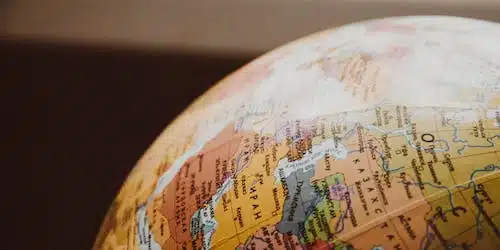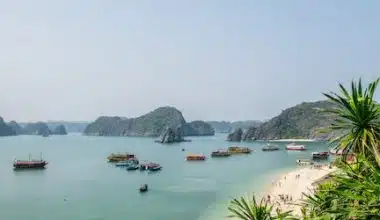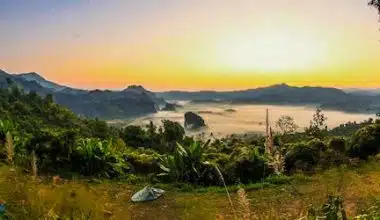Unveil the allure of this nation at the crossroads of Europe and Asia as we explore the question: What continent is Armenia on? Armenia, a landlocked country in Transcaucasia, shares borders with Georgia, Azerbaijan, Iran, and Turkey. With a population of around 2,957,000, it has a rich history, a diverse media landscape, and modern technology. Armenia is known for its rich cuisine, diverse landscapes, and diverse natural landscapes, including the Lesser Caucasus and Armenian Highlands. The country also boasts a parliamentary system and a rich history of winemaking. You can find more information about what continent Armenia is in this post, along with how to plan a trip to Armenia and the features of living in Armenia.
What Continent Is Armenia In?
Armenia is located in the continent of Asia. It is a landlocked country in the region of Transcaucasia, which lies just south of the Caucasus mountain range and is considered the northwestern extremity of Asia. Armenia shares borders with Georgia and Azerbaijan to the north and east, respectively. To the southeast, it is bordered by Iran, and to the west, it shares a border with Turkey. Additionally, there is an exclave of Azerbaijan called Naxvan that borders Armenia to the southwest.
Features Of Living In Armenia
#1. Ancient and Pre-Modern History
Armenia has a rich history that dates back to ancient times. It was once a vast empire that extended from the Black Sea coast to the Caspian Sea and from the Mediterranean Sea to Lake Urmia in present-day Iran. However, it faced constant foreign incursions and eventually lost its autonomy in the 14th century CE.
#2. Geographical Location
Armenia is situated in the region of Transcaucasia, which is considered the northwestern extremity of Asia. It is landlocked and shares borders with Georgia, Azerbaijan, Iran, and Turkey.
#3. Population
As of 2023, the estimated population of Armenia is around 2,957,000.
#4. Government
Armenia has a parliamentary system of government. The head of state is the President, currently Vahagn Kachatur, and the head of government is the Prime Minister, currently Nikol Pashinyan.
#5. Cuisine
Armenian cuisine is known for its rich flavours and unique dishes. Traditional Armenian foods include dishes like dolma (stuffed grape leaves), khorovats (barbecue), lavash (flatbread), and various types of cheese. Armenia is also famous for its wine production, with a long history of winemaking dating back to ancient times.
#6. Media and Press Freedom
Armenia has a diverse media landscape, with television, magazines, and newspapers operated by both state-owned and for-profit corporations. The country guarantees freedom of speech, and it ranks 61st in the 2020 Press Freedom Index. However, there are concerns about judicial harassment of journalists and a lack of transparency regarding media ownership.
#7. Connectivity and Technology
Armenia has access to modern technology and features. For example, wireless carriers in Armenia support features like FaceTime over Cellular, LTE, and Personal Hotspot for iPhone users Additionally, Armenia is included in the availability of features for platforms like watchOS and iOS/iPad.
#8. Natural Landscapes
Armenia is known for its diverse and picturesque landscapes. It is home to beautiful mountain ranges, including the Lesser Caucasus and the Armenian Highlands. Mount Ararat, a dormant volcano, is a prominent symbol of Armenia and is visible from many parts of the country. Armenia also has stunning national parks, such as Dilijan National Park and Khosrov Forest State Reserve, which offer opportunities for hiking, wildlife spotting, and nature exploration.
#9. Historical and Cultural Sites
Armenia is rich in historical and cultural heritage. It is home to many ancient monasteries, churches, and archaeological sites. Some notable landmarks include the Geghard Monastery, which is a UNESCO World Heritage Site; the ancient city of Erebuni in Yerevan; and the religious centre of Etchmiadzin, which is the seat of the Armenian Apostolic Church.
#10. Armenian Genocide Memorial
The Armenian Genocide Memorial, known as Tsitsernakaberd, is important in Yerevan. It commemorates the victims of the Armenian Genocide, which took place during World War I and resulted in the mass killings and forced deportations of Armenians by the Ottoman Empire. The memorial stands as a symbol of remembrance and a testament to the resilience of the Armenian people.
Notable Tourist Attractions In Armenia
Armenia offers a range of tourist attractions that showcase its rich history, stunning landscapes, and cultural heritage.
#1. Yerevan
The capital city of Armenia, Yerevan, is a vibrant and cosmopolitan destination. It features attractions such as the Republic Square, Cascade Complex, Matenadaran (a repository of ancient manuscripts), and the Vernissage flea market.
#2. Garni Temple
Located near Yerevan, the Garni Temple is an ancient Hellenistic-style temple dedicated to the sun god Mithras. It is the only standing Greco-Roman colonnaded building in Armenia
#3. Geghard Monastery
A UNESCO World Heritage Site, Geghard Monastery is a mediaeval monastery complex carved out of a mountain. It is known for its unique rock-cut architecture and beautiful religious carvings.
#4. Lake Sevan
Lake Sevan is the largest lake in Armenia and one of the largest high-altitude lakes in the world. It offers picturesque views, recreational activities, and the opportunity to visit Sevanavank Monastery located on a peninsula.
#5. Tatev Monastery
Situated in the southern part of Armenia, Tatev Monastery is a medieval Armenian Apostolic monastery known for its stunning location on a cliff. It can be reached by the Wings of Tatev, the world’s longest reversible cable car.
#6. Dilijan
Known as the “Switzerland of Armenia,” Dilijan is a resort town surrounded by lush forests and picturesque landscapes. It offers opportunities for hiking, nature walks, and visits to historic sites like the Haghartsin Monastery.
#7. Noravank Monastery
Noravank Monastery is a 13th-century Armenian Apostolic monastery located in a narrow gorge. It is renowned for its intricate stone carvings and stunning red rock formations.
#8. Khor Virap
Khor Virap is a monastery located near the border with Turkey and offers breathtaking views of Mount Ararat. It is known for its historical significance and as a pilgrimage site.
#9. Vanadzor
Vanadzor is Armenia’s third-largest city and serves as a base for exploring the beautiful Lori region. It features attractions such as the Vanadzor Botanical Garden, a fine art museum, and mineral springs.
#10. Amberd Fortress
Dating back to the 7th century, Amberd Fortress is a well-preserved fortress located about an hour’s drive from Yerevan. It offers panoramic views of the surrounding mountains and valleys.
How to Plan a Trip to Armenia
Planning a trip to Armenia involves several key considerations.
These steps can help you plan your trip
#1. Research and Decide on the Duration
Determine how long you plan to stay in Armenia. This will help you create an itinerary and allocate time for various activities and attractions.
#2. Check Travel Advisories
Before traveling, it’s essential to check the latest travel advisories and safety information for Armenia. Visit the official website of your country’s foreign affairs department or the U.S. Department of State’s website for updated travel advisories.
#3. Choose the Best Time to Visit
Armenia experiences four distinct seasons. The spring (April to June) and autumn (September to October) months are generally considered the best times to visit due to pleasant weather and vibrant landscapes. However, each season has its charm, so consider your preferences and the activities you plan to engage in.
#4. Create an Itinerary
Research the various tourist attractions and destinations in Armenia and create an itinerary based on your interests and the duration of your stay. Consider visiting places like Yerevan, Garni Temple, Geghard Monastery, Lake Sevan, Tatev Monastery, and Dilijan.
#5. Book Accommodation
Look for suitable accommodation options in the cities or regions you plan to visit. Yerevan offers a range of hotels, guesthouses, and apartments to choose from. Consider factors such as location, amenities, and budget when making your booking.
#6. Transportation
Determine how you will get to Armenia and how you will travel within the country. Yerevan has an international airport, and there are also land border crossings with neighboring countries. Consider renting a car, using public transportation, or hiring a driver/guide depending on your preferences and comfort level.
#7. Pack Accordingly
Consider the weather and activities you plan to engage in when packing for your trip. Armenia has diverse landscapes, so pack comfortable walking shoes, appropriate clothing for different weather conditions, and any specific items you may need for activities like hiking or visiting religious sites.
#8. Travel Documents and Insurance
Ensure that your passport is valid for at least six months beyond your planned departure date. Check if you require a visa to enter Armenia and apply accordingly. It’s also advisable to have travel insurance that covers medical expenses and trip cancellations.
#9. Health and Safety
Consult with your healthcare provider or a travel clinic to ensure you are up to date on any necessary vaccinations for Armenia. It’s also a good idea to carry a basic first aid kit and any necessary medications.
#10. Currency and Communication
Familiarize yourself with the local currency (Armenian Dram) and exchange some currency before your trip. Consider obtaining a local SIM card or an international roaming plan for communication purposes.
Do’s And Don’t Of The Asian Country When Visiting Armen
They include.
#1. Avoid Discussing Sensitive Political Topics
Armenia has a complex political history, including conflicts with neighboring countries. It’s advisable to avoid engaging in discussions about sensitive political topics, such as the Nagorno-Karabakh conflict or the Armenian Genocide, unless you are well-informed and prepared for respectful conversations.
#2. Respect Religious Sites And Customs
Armenia has a strong religious heritage, particularly with the Armenian Apostolic Church. When visiting churches, monasteries, or other religious sites, dress modestly and follow any guidelines or rules provided. Be respectful of ongoing religious ceremonies and avoid disruptive behavior.
#3. Exercise Caution Near The Armenia-Azerbaijan Border
Due to the ongoing conflict between Armenia and Azerbaijan, it is important to exercise caution near the border areas. The U.S. Department of State advises against non-essential travel to the border region and recommends being aware of checkpoints and potential road closures.
#4. Avoid Discussing Controversial Historical Events
The Armenian Genocide is a sensitive topic, and discussions about it can be emotionally charged. It’s important to approach the topic with sensitivity and respect. Avoid making insensitive comments or engaging in debates without proper knowledge and understanding of the historical context.
#5. Be Cautious With Wildlife And Nature
Armenia has diverse wildlife, including snakes. When exploring nature reserves or hiking trails, be cautious and aware of your surroundings. It’s advisable to stay on designated paths and avoid touching or provoking wildlife.
#6. Respect Local Customs And Traditions
Armenians have their customs and traditions, and it’s important to respect them. For example, it is customary to greet people with a handshake and maintain eye contact during conversations. Avoid disrespectful behavior or actions that may be considered offensive.
#7. Photographing Sensitive Areas
Some areas, such as military installations or border regions, may have restrictions on photography. Respect any signage or instructions and avoid taking photographs in prohibited areas.
#8. Overlooking Safety Precautions During Outdoor Activities
If you plan to engage in outdoor activities like hiking or skiing, ensure you are adequately prepared. Follow safety guidelines, carry necessary equipment, and be aware of weather conditions and potential risks.
#9. Disregarding Waste Management
Be mindful of proper waste disposal and recycling practices. Use designated trash bins and avoid littering in public areas or natural sites. Respect the environment and help maintain the cleanliness of the places you visit.
#10. Engaging In Unethical Tourism Practices
Avoid participating in activities that exploit animals or harm the environment. Be responsible when interacting with wildlife, and choose tour operators or activities that prioritize ethical and sustainable practices.
Is Armenia Part Of Asia Or Europe?
Armenia is geographically located in the South Caucasus region, which is at the crossroads of Europe and Asia. Geopolitically, Armenia is generally considered part of Europe due to its alignment with European organizations and cultural ties. However, geographically, Armenia is situated in Asia. The classification of Armenia as either European or Asian can vary depending on different perspectives and criteria.
Is Armenia On Two Continents?
Armenia is geographically located in the region of Transcaucasia, which is considered the unofficial border between Europe and Asia. While Armenia is situated in the western part of Asia, it has historical and cultural ties to both Europe and Asia. The country has been influenced by various empires and civilizations throughout its history, including the Roman, Byzantine, Ottoman, Persian, and Arab empires.
What Is The Currency In Armenia?
The currency in Armenia is the Armenian Dram (AMD). The drama was first introduced on November 22, 1993, after Armenia withdrew from the rouble zone, which was an attempt to maintain a common currency among CIS states after the collapse of the Soviet Union. The dram is the official currency of the Republic of Armenia and is also used in the unrecognized Republic of Artsakh alongside the Artsakh dram. The currency is divided into smaller units called lum, with 1 dram being equivalent to 100 lum Banknotes in circulation include denominations of 1,000, 5,000, 10,000, 20,000, 50,000, and 100,000 drams, while coins come in denominations of 10, 20, 50, 100, 200, and 500 drams.
Is Armenia A Part Of The US?
No, Armenia is not a part of the United States. Armenia is an independent country located in the region of Transcaucasia, between Europe and Asia. It is a sovereign nation with its own government, currency, and international relations. While Armenia and the United States have diplomatic relations and participate in various international organizations together, Armenia is a separate and distinct country from the United States.
How Much Is 1 Armenia To A Dollar?
1 Armenian Dram (AMD) is equivalent to approximately 0.00248 United States Dollars (USD). However, the exchange rates can fluctuate and may vary depending on the source and the specific time of the transaction.
What Country Is Armenia Close To?
Armenia is located in the region of Transcaucasia and shares borders with several countries. It is bordered by Turkey to the west, Georgia to the north, Azerbaijan to the east, and Iran to the south.
Conclusion
Armenia’s rich history, stunning landscapes, and cultural heritage are showcased in its tourist attractions, including Yerevan, Garni Temple, Geghard Monastery, Lake Sevan, and Tatev Monastery. When visiting Armenia, it’s crucial to avoid discussing sensitive political topics, respect religious sites and customs, exercise caution near the Armenia-Azerbaijan border, avoid discussing controversial historical events, be cautious with wildlife and nature, respect local customs and traditions, avoid photographing sensitive areas, follow safety precautions during outdoor activities, and be mindful of waste management. Be prepared for potential risks and ensure proper disposal of waste.
- BEST BEACHES IN VIETNAM
- Best Vietnam Tours Destinations & Packages In 2023-2024
- BEST TIME TO VISIT SWITZERLAND: Detailed Guide
- CHEAPEST COUNTRIES TO VISIT



